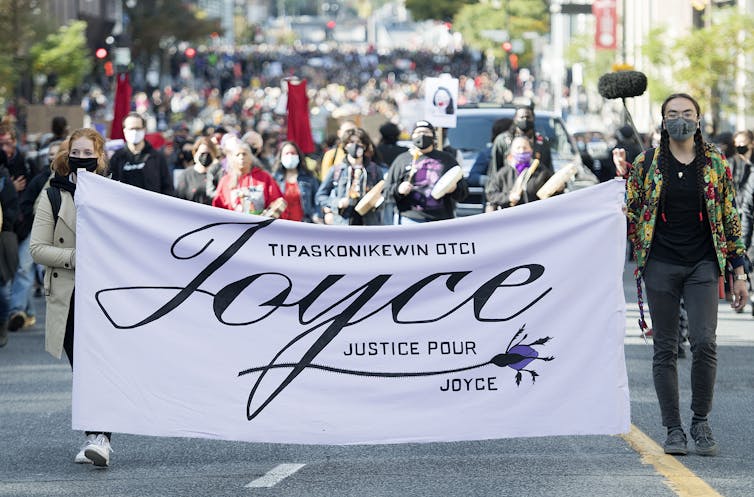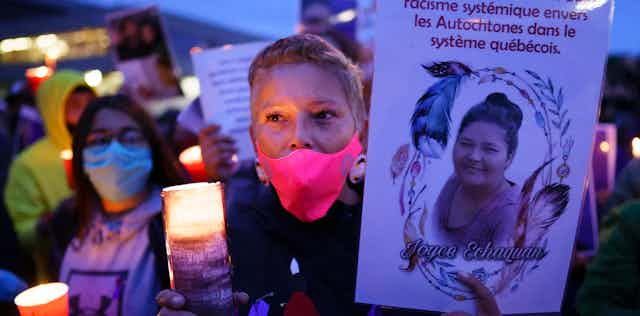The horrific death of Joyce Echaquan, from the Atikamekw Nation in Manawan, has sparked conversations on systemic racism in Canada. Echaquan heard racist and degrading comments from health-care workers at a hospital in Joliette, Que., north of Montréal, in the moments before she died on Sept. 28.
Systemic racism is a blatant problem in the health-care system. The circumstances surrounding Echaquan’s death provide a poignant example of the racism Indigenous people experience in the health-care system. It lies at the interface of interactions between patients, health-care providers and institutional structures. But a solution — cultural safety — does exist.
Since 2018, the research partnerships that I have developed with the Manawan community have made it possible to document the racism faced by Atikamekw in the health-care system. Together we are trying to define and implement solutions based on cultural safety, an approach that places Indigenous culture at the centre of health care.
A colonialist system
In September 2019, retired Superior Court justice Jacques Viens released a report on the treatment Indigenous people by the public service in Québec. The Viens Commission report made it clear that the Québec health system is built on colonial policies that perpetuate power imbalances and social exclusion. Colonialism is embodied in the organization of health-care programs and practices, which are built on the values, principles and perspectives of the dominant western culture and are poorly adapted to the needs of Indigenous people.
Western medicine, for example, is based on a biomedical model of health, while many Indigenous cultures view wellness holistically, integrating the spiritual, emotional, mental and physical dimensions of health.

Health services in Canada are built and managed in accordance with western worldviews, reinforce western cultural supremacy, socially and politically disavowing the traditional, millennia-old health practices and knowledge of Indigenous Peoples. As a reflection of the structural racism embedded in social institutions, interactions between Indigenous people and health-care providers are often characterized by stigma, discrimination and racism.
The effect of racism on health
Racism has disastrous consequences on the health of Indigenous people, whose communities already face more health challenges than others due to precarious social conditions.
The scientific literature shows that people who experience racism and discrimination tend to anticipate encounters with health-care professionals, underutilize health-care services and under-report their symptoms to doctors and nurses. This increases health inequalities by hindering disease detection and the provision of appropriate care.
Racism in health care comes in addition to other micro-aggressions and environmental stressors, which affect individual capacity to adapt and to cope with social and contextual challenges. This chronic exposure to various stressors precipitates a decline in biological functions, increasing the risk of disease for Indigenous people. This is a phenomenon described by research as “allostatic load,” which has been documented for several racialized and minority groups.
Reversing the power imbalance
Culture has long been recognized as a fundamental element in promoting healing and improving health in Indigenous communities. Cultural safety is a transformative approach to health-care that was developed by Irihapeti Ramsden, a Māori nurse. It refocuses health care on the needs, values, rights and cultural identity of Indigenous people. Its goal is to dismantle the colonialism that underlies the health-care system by taking into account the social, cultural, economic and political factors that influence the health of Indigenous people.
Read more: An Inuit approach to cancer care promotes self-determination and reconciliation
Cultural safety requires the development of equal partnerships between health professionals and Indigenous communities. This approach implies that patients and professionals engage respectfully and actively participate in health-care delivery, while aiming to protect the cultural identity of the patients. In keeping with this perspective, the core characteristics of culturally safe care must be defined by the communities receiving the care, in accordance with their own values and cultural norms. The goal is to reverse existing power relations by giving a central place to the historically marginalized voices of Indigenous populations.
Reducing barriers
Cultural safety can be deployed in health care in several ways. For example, a greater prominence of Indigenous doctors, nurses and other health-care workers. Cultural safety also requires improving professionals’ cultural competencies and their skillset for implementing safe and respectful treatments. Professionals must learn to recognize the influence of their own culture on the care they provide, be aware of their privileges and their position of power within the health-care system.
In addition, a number of efforts aim to reduce the barriers to care for Indigenous people by providing interpreters, liaison and co-ordination services for patients. A popular model in the literature is the “patient navigator” model, where peers or health professionals act as intermediaries between the patient and the health-care system.
Navigators can fulfil a variety of roles, booking appointments, arranging transportation, accompanying patients to consultations and translating or disseminating professional recommendations. They may also provide emotional support or refer patients to community support resources.
From an organizational point of view, other interventions might involve to increase services offered to Indigenous populations, such as anchoring Indigenous spirituality in traditional health practices. Another way to promote cultural safety is to change organizational structures so they include the voices of the communities served, so they are better positioned to support changes in practices.
In short, this concept applies at different levels, with the ideal being the implementation of various strategies that act in synergy. All of these solutions require strong partnerships with the communities concerned, as well as sustained political will. This political will must begin with the formal recognition of the existence of systemic racism and the right of access of Indigenous people to health services free of discrimination — as proposed by the Manawan Atikamekw Council in what they have named Joyce’s Principle.


